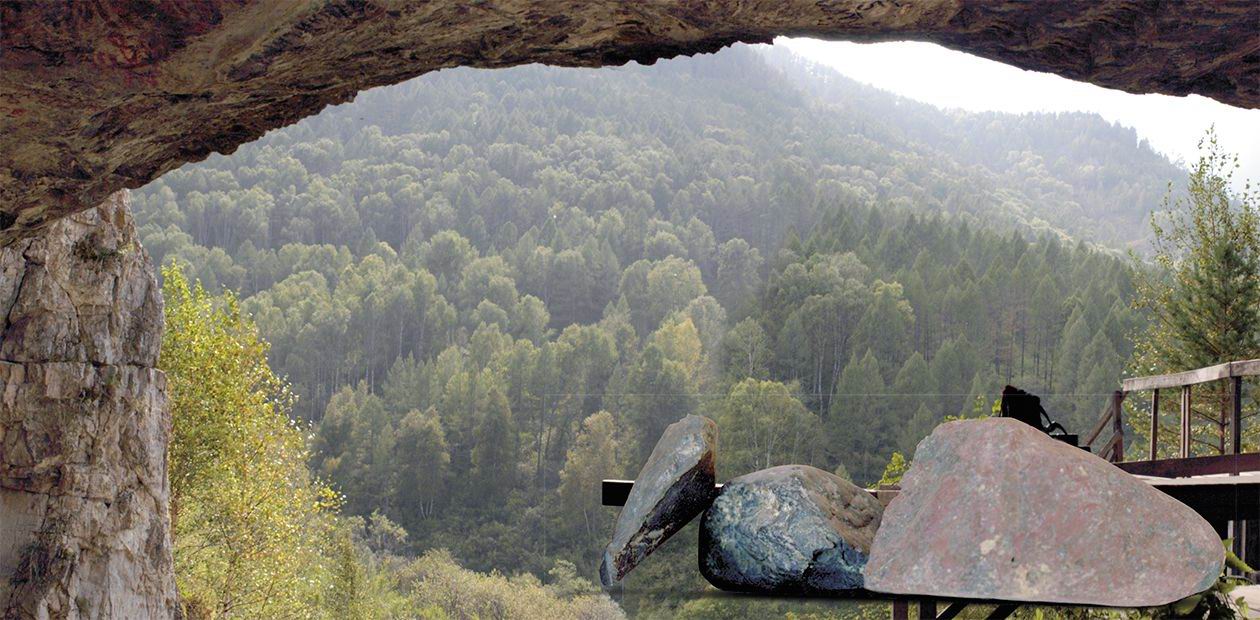The Denisova cave – everything changes, but nothing disappears
The Denisova Cave in the Mountainous Altai (Gorny Altai) – a unique Paleolithic monument and the most ancient inhabited cave of Siberia – has enjoyed well-deserved popularity for quite some time. The stream of inquisitive people never dries up: local residents, tourists, reporters, not to mention archaeologists and other scientists, from geologists to paleontologists. This spring, however, the cave became world famous thanks to the genetic analysis of the human remains found in one of its galleries, which showed that 50,000 years ago the cave was populated by hominins of a previously unknown species, more ancient than the Neanderthals.
Since that time both the cave and the science and research camp of the Novosibirsk Institute of Archaeology and Ethnography, SB RAS, have turned into a major attraction for tourists and journalists including the famous “National Geographic.” “SCIENCE First Hand,” which has published many time the authors’ materials about the achievements of Siberian archaeologists, made no exception. The purpose of the current publication is not only to tell the readers about the multi-year research conducted in the Anui Valley but also to introduce them to the people working there – today’s “inhabitants” of the famous cave
Omnia mutantur, nihil interit.
(Everything changes but nothing disappears).
“Metamorphoses” by Ovid
The Denisova Cave – a research site of the Novosibirsk-based Institute of Archaeology and Ethnography (IAET), SB RAS, in Gorny Altai – is 20 years old. The Denisova Cave – a unique archaeological site – is about 300,000 years old. In ancient times, a hidden cavern formed in the interior of the Anui ridge; gradually it widened and deepened under the influence of water flows. When the river valley became deeper, the cave came out into the open.
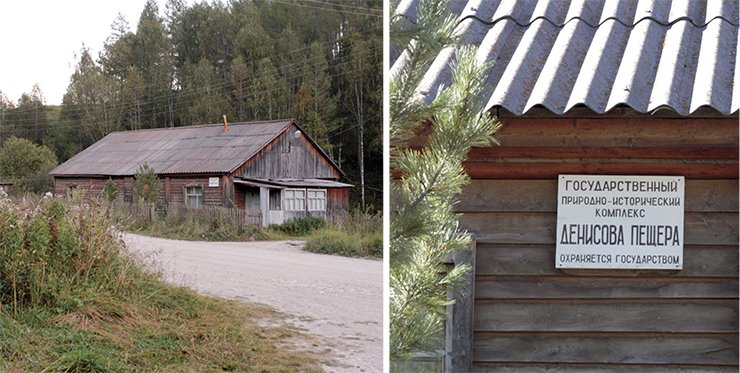
Today, the river flow runs about thirty meters below the cave entrance, while in the time past it used to be right at the foot of the ridge and flooded the cave during high-water season. The cave remained uninhabited for some time and then, for almost 280,000 years it became a home, first for animals and later for man.
The cave “opened” for the scientific community in 1977, when the well-known paleontologist N. V. Ovodov, at the instruction of the head of the Siberian school of archaeology Academician A. P. Okladnikov, explored the cave for the first time. Two four-meter-deep test pits yielded a rich archaeological material: fragments of ceramics, bone and bronze artifacts, numerous stone tools and flakes. All these findings proving that the cave had been populated since the Paleolithic times became a big event in national archaeology.
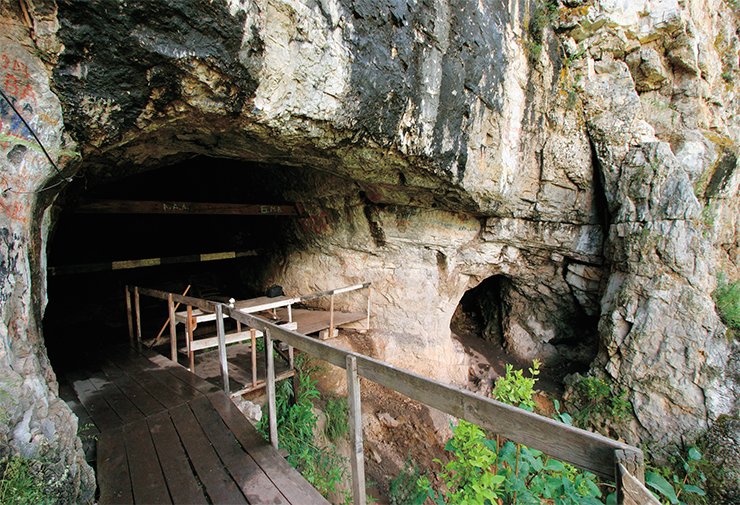
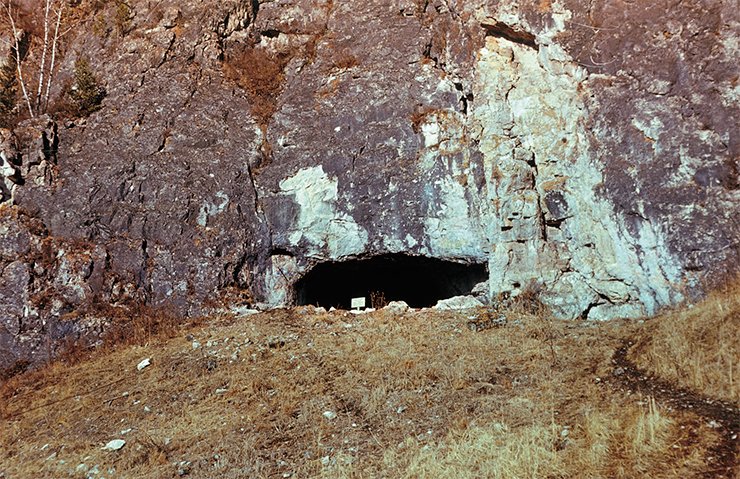
During the following field seasons, IAET SB RAS teams studied the cave, regularly discovering new layers of deposits. Rich with artifacts, they uncovered a true chronicle of humankind, from the Middle Paleolith to Middle Ages. It became clear that the Denisova Cave was a unique archaeological monument, second to none in North Asia. It was decided to build a research camp on the bank of the Anui River.
There are no little things for archaeologists
Archaeologists’ work in the field is not an easy thing and not nearly as romantic as it might seem at first glance. Their main “scientific” instruments are entrenching tools. The stationary research done in the Denisova Cave successively opened loose deposits in the central hall, in the area in front of the entrance and in the estuarial zone of the southern and eastern galleries. A measure of the scale of the field work is the depth of the dig, which in the central hall is 6.5 meters from the so-called “zero” line showing the deposits level at the beginning of the excavations.
The work is performed carefully and methodically. The surface designed for digging is marked out using a theodolite into squares a meter on a side. After that, archaeologists pick out successive layers of soil with the help of knives and brushes to the depth of about 5 centimeters.
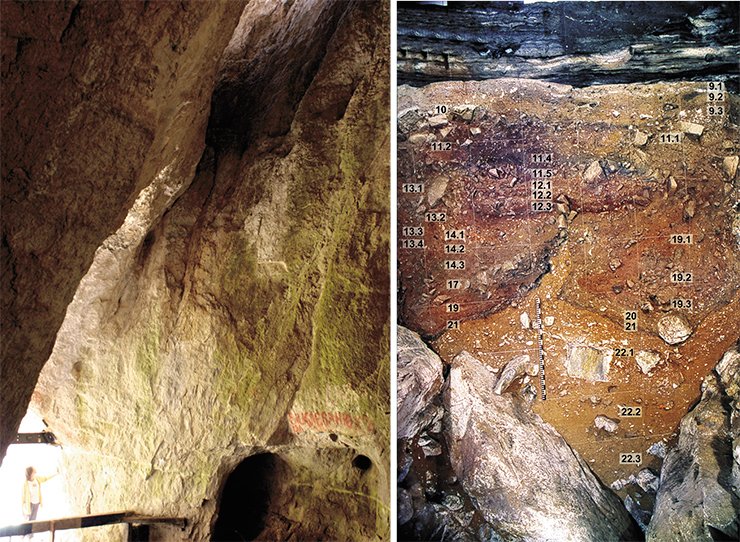
The Altaians call the cave Ayu-Tash (Bear Stone); their hoary myths tell of a powerful Black Shaman who lived in this darkness and could turn into a huge bear …
There is another sad and beautiful legend associated with the Deniska, which appeared in the neighboring villages right after the Russian Civil War (1917—1923). It tells us about a White Virgin, a desolate young beauty, who hid forever in the cave galleries not to cast in lot with a hateful fiancé.
There is more in this cave than meets the eye… The philosopher N. K. Roerich, who visited it during his Altai expedition back in 1926, noticed a special energy field present in the hollow emptiness. In his draft travel notes, he wrote, “Some pleasant feeling that filled my conscience when I was in the cave did not leave me for a very long time.” From: (Isupov, 2009)
Large findings are photographed in situ, and their location is recorded. The head of the dig – there is such a position! – writes down the data in the log, puts the findings into special packets and marks them indicating the layer, square and layer of the dig. The dug out soil is put in buckets, marked and passed for washing.
The buckets filled with deposits are brought down to the river. Successive washings through the screens of different mesh size produce “concentrate,” which is sorted out by fractions and sent to a laboratory having all the things needed for work: a microscope, chemicals for express analysis and a computer.
All the material collected is carefully cleaned, sorted and measured. Those who explore the Paleolithic culture have no such notion as “archaeological garbage.” Everything is of interest: soils, flints, tiny animal bones. The things unclaimed today may prove to be of huge scientific value tomorrow thanks to new methods. All the material dug in the Denisova cave is carefully stored in the institute.
One man is no man
What is unique about the multilayered deposits of the Denisova Cave is that they are well preserved and easily stratified within the system of geological sediments, which ensures quite an accurate dating of the artifacts contained in them. To date the findings more precisely, radiocarbon, geomagnetic and thermoluminiscent testing is used.
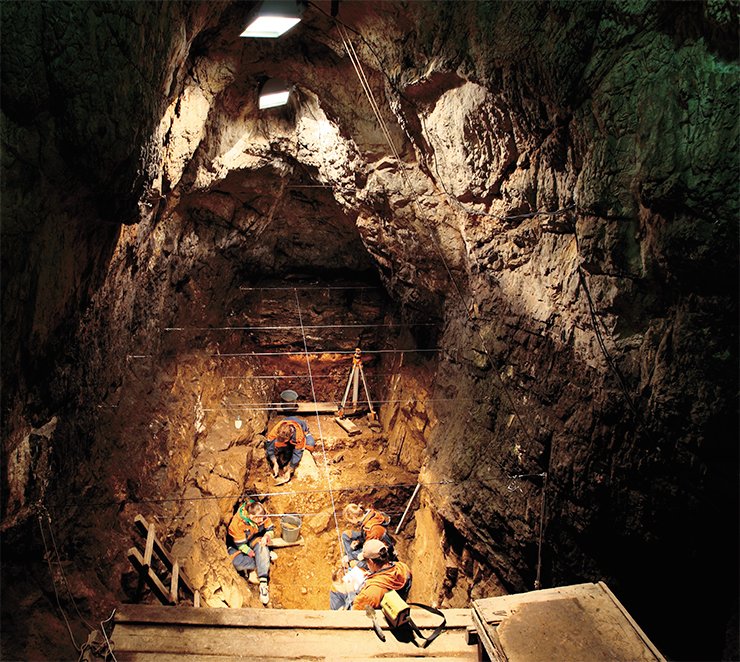
Throughout the sequence, the archaeological material is accompanied by numerous organic remains: plant pollen, fossil clamshells, and bone remains of birds, small and large mammals. This rich material gives the researchers a most rare opportunity to reconstruct the environmental and climatic conditions in the vicinity of the cave existing in those distant ages when ancient people lived there.
Since the very beginning, the study of the Denisova Cave, similarly to the studies of other Paleolithic sites in Altai, has been interdisciplinary. Side by side with archaeologists, there worked scientists specializing in a wide variety of natural disciplines: geologists, paleozoologists, paleobotanists, paleopedologists, and petrographers. Academician A. P. Derevianko managed to collect a strong research team whose skeleton staff included, among others, paleozoologist A. K. Agadzhanian from the Paleontology Institute RAS, paleobotanists L. M. Malayeva and N. S. Boliakhovskaya and geologist V. A. Ulianov from Moscow State University. Every year scientists from the capital come to the Anui Valley to be directly involved in fieldwork.
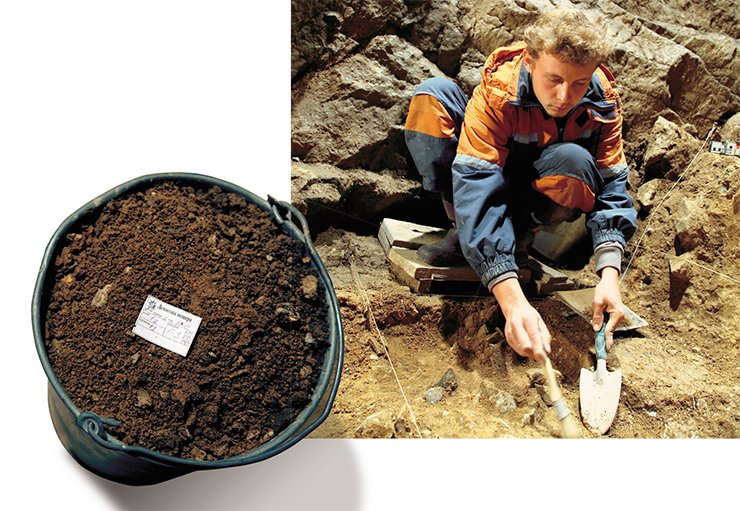
Examining the plant spores, pollen, and seeds contained the cave deposits, paleobotanits determine the species involved in ancient plant associations. For instance, they have discovered that hundreds of thousands years ago in the environs of the cave grew oaks, hornbeams, elm-trees and other broad-leaved species exotic for the modern Altai flora.
The bone remains help to reconstruct ancient fauna. For example, scientists have wondered for long whether mammoths had lived in the vicinity of the cave. Among the discovered tens of thousands of bone remains attributed to various animals, there are a just a few that belong to the mammoth. Today, paleontologists are sure that virtually all of these bone remains are tooth enamel sheets and tusk fragments. Evidently, the ancient man found them beyond the Anui Valley and brought them to the cave to make decorations.
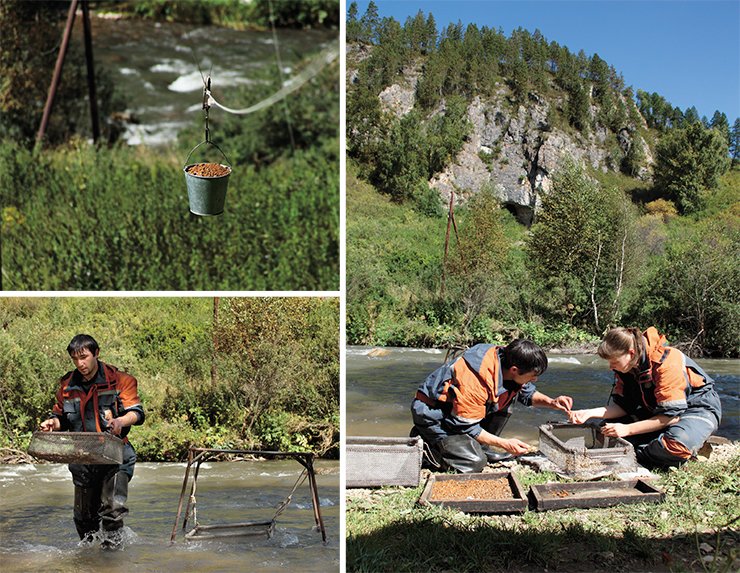
The main production activity of the early man was making stone tools. Therefore, for over 15 years archaeologists have been collaborating with a specialist in mineralogy and petrography of Novosibirsk State University N. A. Kulik, whose research has reconstructed a complete picture of the development of the raw materials base of the early stone industry.
In the primeval valley of the Anui
The availability of a stable raw materials base for tool production in the Anui basin was a major attraction of this area for the early human community. This, however, was not the only advantage: of great value were the unique environmental and climatic conditions and the surrounding plant and animal world.
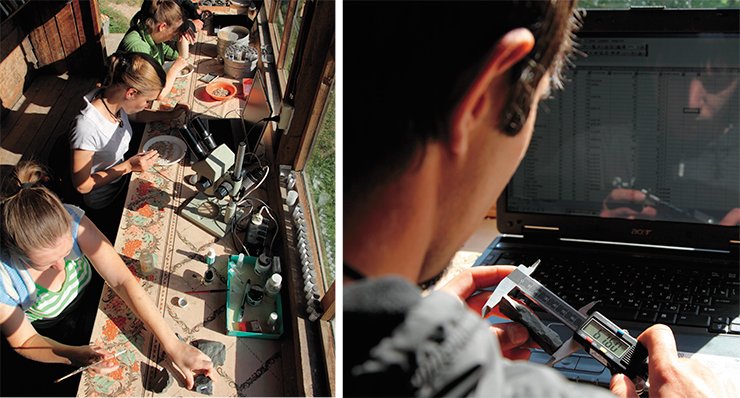
Pleistocene, which encompassed all the main events of the most ancient human history, is often referred to as the Great Ice Age. It includes several ice periods alternating with interglacial warmings. The last ice period in Siberia – the Sartan Ice Age – began about 24,000 years ago. It was preceded by a long period of comparative warming. It was during this epoch, about 50,000—30,000 years ago, that the girl whose nail-bone was found in one of the Denisova Cave galleries lived. The finding suggested the existence of a new hominin species, Homo sapiens altaiensis.
The climate at the time was quite cool (the average January temperature was –6.5 °C, and the average temperature of July was 18—21 °C), though the absolute minimum did not go below –35 °C, and the temperature in May and September did not fall below zero.

By that time the once rich forest vegetation of the valley had shrunk, giving way to steppes, grasses, bushes and meadows. The small forests were mostly made of fir mingled with cedar and pine. The thermophilic broad-leaved tree species, which used to be common representatives of the Altai flora, had virtually disappeared.
The spreading of the areas with a thick herbaceous layer resulted in an increase in the number of hoofed animals: the primeval bison, horse, Siberian red deer, argali, Mongolian gazelle, and yak, as well as the carnivores, hyena and wolf. Rodents, especially rodent-moles, proliferated. Among the birds naturally domineered the species typical of open landscape.
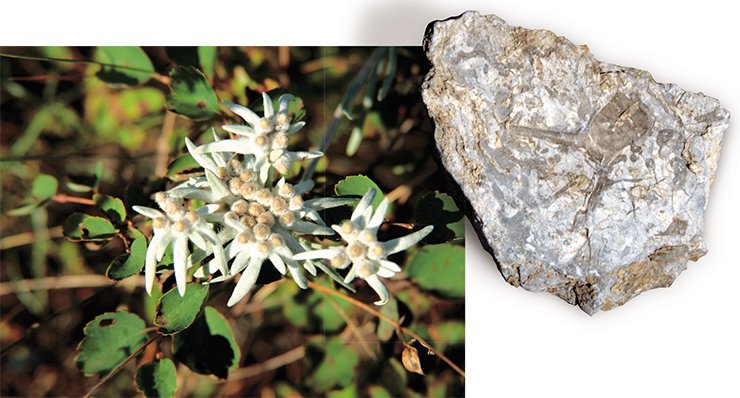
Further worsening of the climatic situation deriving from the global drop in temperature would lead to the formation of local glaciers on the northern slopes of the ridges surrounding the Anui Valley and expansion of the snow belt. Dark coniferous forests would be forced out to the lower levels of the valley, and the mountainsides would be covered with grass meadows. Dominating among small and large mammals would be the representatives of the mountain-steppe groups: the high-mountain vole, steppe lemming, long-tailed souslik, as well as Siberian goat, hyena, dzeren (Mongolian gazelle), saiga, and argali. The local mammal structure would easily accommodate the Arctic fox, a typical representative of the tundra biotopes.
The next warming would only occur many millennia later. It would mark the start of the Holocene – a new geological epoch, which is 10,000 years old.
Altai shelter
Summing up the material obtained from studying the multilayer deposits of the Denisova Cave, one may state that from the first appearance of man in the Anui River basin and during the whole period of his development the environmental conditions were exceptionally favorable as compared with the rest of North Asia. The North-Western Altai was in fact a special refugee zone, which became a shelter for many animal species, including humans.
Thanks to the contrasting structure of the mountainous relief, the Anui Valley was protected from the active influence of ancient glaciers, which developed high in the mountains. Neither the surroundings nor the plant or animal world show any traces of the sharp changes unfavorable for humans, which were recorded in the Siberian plains during the cold periods.
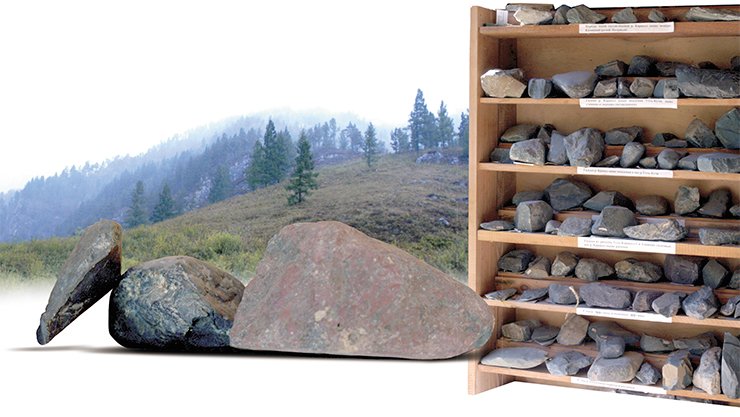
In comparison, sedimentary rocks are much softer, more fragile and anisotropic (their strength is directionally dependent). When cleft, either along natural lines of division or along cracks, they form many fragments. A proof of that is a multitude of pebbles in the shape of bars and parallelepipeds. As these shapes of sedimentary rock fragments are quite monolithic and homogeneously strong, they make a good raw material for tool production.
The early man needed to take into account all these properties of pebble raw material, and the ancient artisan intentionally chose the strongest and most homogenous pebbles among a great variety of lookalike pebbles with different petrographic properties. Interestingly, his choice was virtually infallible, as the results of archaeological and petrographic examination show
To this we can add the natural complexity of the environment with various landscapes, from forests to meadows and mountains, found side by side. The valley itself can narrow to a canyon or expand to a steppe, with true mountainous taiga growing along the anastomosing branches of the river. The Denisova Cave is located in the narrow, canyon-like part of the valley, offering a shelter secured from any side.
During the hunting season, the ancient man could go to the Karakol mouth, where animal migration paths crossed and the area was well within view for many kilometers. Besides, the open plain was “near at hand” – just 100 kilometers away, which the ancient man could cover in two days. And that was a different climate with a different wildlife… To this effect, the Anui Valley was a special “contact zone” between different natural landscapes and communities, which was bound to attract the early man.
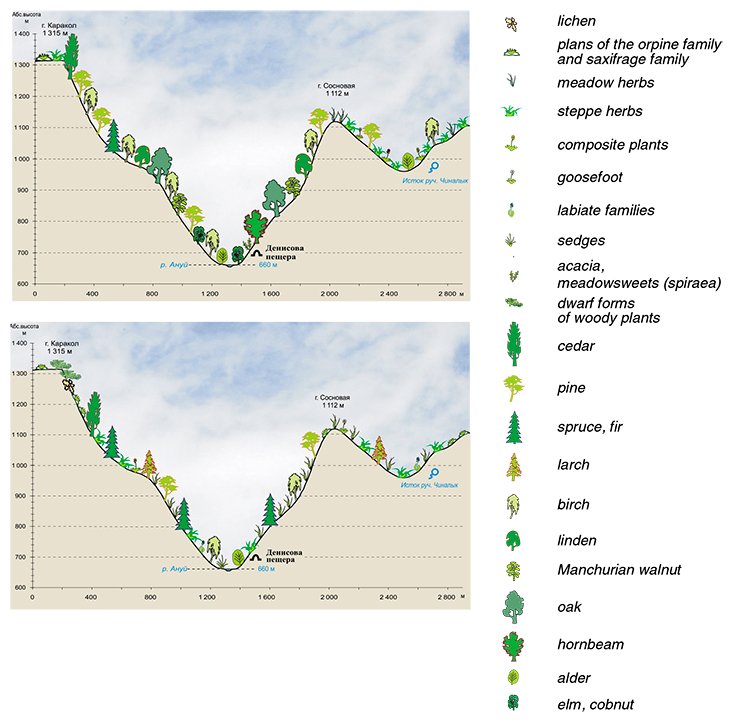
As consequence, the unique combination of favorable environmental conditions allowed the human community to reach an unbelievably high development level, and testifying to it is the fact that the Upper Paleolithic period started here earlier than in Europe.
Living and working at the Deniska*
Today, in the third millennium AD, the unique Denisova Cave still lures many. The stream of curious people – local residents, tourists, reporters – never dries up… But the main “inhabitants” of the cave are still archaeologists.
The cave has been studied for over 30 years. It all began from a tent camp. In 1986, the first house was built, which had living quarters and a laboratory. On the iron rods of the bridge across the rapid Anui there is a date – 1990 – marking the start of intense construction of a science and research camp. It was during the 1990s, the time not easy for science and country as a whole, that the main living, research and maintenance premises were built.
The construction was mainly done under our own steam: research workers, drivers, photographers and scientists dug trenches, laid pipes, and erected houses… The work was done quickly, at high quality standards and with minimal costs. This is not surprising as archaeologists, because of the nature of their work, can do anything: organize a dig site, set up camp, and feed people… Today, the research camp is a small settlement with modern conveniences having everything necessary for living and working: dwelling houses, laboratories, canteens, baths, a laundry and a truck park.
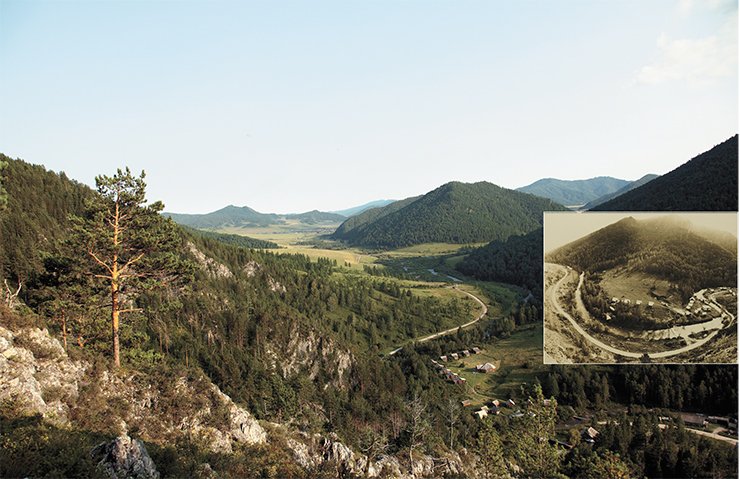
We can distinguish several stages in the natural conditions development in the Anui Valley. During the initial stage, the warmest interglacial period (240,000—180,000 years ago), forest landscapes prevailed. Northern slopes were overgrown with mixed pine-birch forests, and ridge tops were crowned with cedar and spruce whereas at the foot of the mountains, in well warmed areas, grew broadleaved trees like hornbeam, elm, linden and Manchurian walnut. The southern slopes of the valley were covered with wild grasses. Along the Anui streambed stretched fringe groves of alder trees, and the banks were overgrown with willows and currants.
Later, owing to the global drop in temperature during the Upper Pleistocene, the forest vegetation of the valley shrank giving way to steppes, grasses, bushes and meadows. By and by, broadleaved species of trees disappeared.
Further cooling down, with the lowest temperatures occurring 20,000—18,000 years ago, led to the formation of local glaciers on the northern slopes of the ridges and expansion of the snow belt. Dark coniferous forests (mostly spruce and cedar) were forced out to the lower levels of the valley while the share of grassy plants reached a maximum. The mountainsides were covered with grassy meadows, and the rocky, well warmed slopes developed short-grass dry-steppe complexes of briar, barberry, pea shrub, etc. In the upper stories of the valley altiplain vegetation formed (bunchgrass herbs, labiates, short spiraea typical of rock streams, etc.)
Deniska, as the researchers call their expedition home, is the pride of our research institute, the apple of its eye. It has a special atmosphere, which shows in social relations, attitude to work and attitude to the environment. If you take a walk around the camp, you will not find a single stub or candy wrapper: they don’t litter here not because this is prohibited but because this is not done.
There are no bystanders in this united team, even though up to 300 people come here just in one season! Typically, the archaeological excavations involve, in addition to the institute’s staff, undergraduates, high schoolers and volunteers. Digging is hard work, both physically and psychologically – it is not easy to work without letup in a cold cave eight hours a day, picking out with a knife layer upon layer when the sun is shining and river lapping a stone’s throw from you. No one is forced or coaxed to come here – people come with their heart and not because they have to.
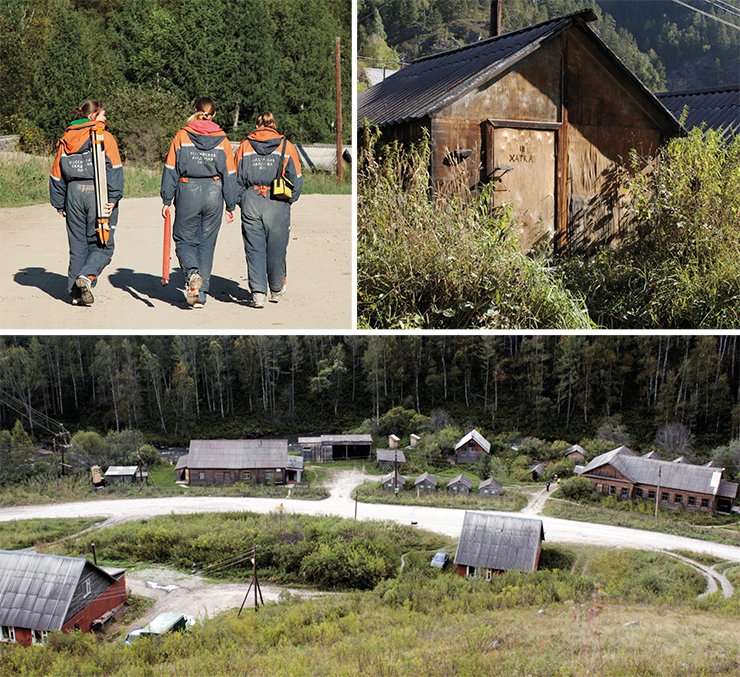
For many years, the archaeologists have been working closely with the teachers of local schools (including schools based in the town of Biysk). Those willing to work are many, so they undergo a rigorous selection, and only the most reliable, hardworking and responsible get an offer. It happens very rarely that somebody cannot take it and leaves.
This cooperation is many years old; it continues from generation to generation. On the one hand, the station has full-time employees; on the other hand, there is an experience of working together with newcomers towards a common goal, when the young get the valuable skills of communicating in large teams. If a dozen years ago the parents were doubtful about letting their children go to the Deniska, today they feel easy about it. Many of the teachers who have worked at the dig in their time currently run archaeology study groups at schools and bring their students here.
Today, our archaeology station is a kind of a visiting card of North-Western Altai. There is no problem here with popularizing science and strengthening the status of researchers – life itself has solved these topical problems, and good neighborly relations with local residents and administration help to deal with pressing challenges.
Archaeological works, however, is just one area of the many activities conducted at the Deniska. Recently, organizing scientific events has been acquiring increasing importance. Frequent visitors here are participants of big national and international scientific conferences and symposiums. Services include a specially equipped conference hall, a spacy dining room and houses with all comforts.
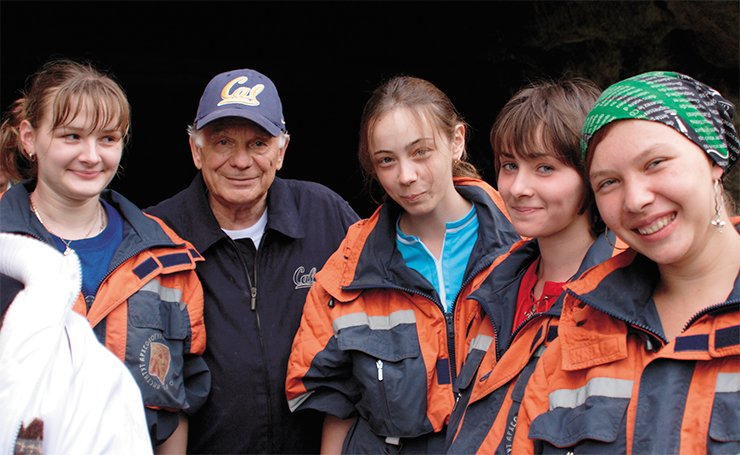
Mathematicians, geneticists and geophysicists have held their scientific forums here. And yet, the most welcome guests are archaeologists. Archaeology is a very particular science: researchers need to see everything with their own eyes, study the structure of geological deposits by themselves, and hold the artifact in their hands…
In recent years, a few interdisciplinary symposiums dedicated to Paleolith have been held here, and their participants had a chance to get familiarized on the spot with the research results of the Novosibirsk school of archaeology and to see that the scale and magnitude of the Paleolithic studies conducted at the Denisova Cave meet the highest global standards.
*The affectionate-diminutive of the Denisova Cave
References
Agadzhyanyan A. K., Shunkov M. V. Evolution of the Quaternary Environment in the Northwestern Altai // Archaeology, Ethnography and Anthropology of Eurasia. 2009. V. 37. N. 2. P. 2—18.
Derevianko A. P., Kulik N. A., Shunkov M. V. Geological factors of the development of Paleolithic industries in North-Western Altai // Results and Prospects of the Geological Studies of Gorny Altai. Gorno-Altaisk: Gorno-Altaisk publishing House. 2000. P. 143—147.
Derevianko A. P., Shunkov M. V. Agadzhyanyan A. K., et al. Paleoenvironment and Paleolithic Human Occupation of the Gorny Altai. Novosibirsk. Institute of Archaeology and Ethnography, SB RAS Press, 2003. 447 p.
Isupov S. Yu. The Biysk fortress is the main… Barnaul: Azbuka. 2009. 304 p.
Shunkov M. V. Paleogeographic context of the early Upper Paleolith in Altai // Northern Eurasia in anthropogene: man, paleotechnologies, geoecology, ethnology and anthropology. Irkutsk: Ottisk. 2007. V. 2. P. 316—321.
The editors thank S. I. Zelensky, M. T. Sapronova, and N. Shvedova for their help with the publication


